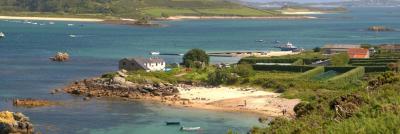


Tiny island of big contrasts
Web: www.bryher-islesofscilly.co.uk
Web: www.visitislesofscilly.com/explore/bryher
The island of Bryher offers beauty and contrast, from wild Hell Bay in the north to the peaceful white sand and wild flowers of Rushy bay on the southern tip. In spring, there is a profusion of colour with daffodils and narcissi in every hedgerow and field corner. In autumn, many migratory birds use Bryher as a resting place and gales frequently lash the western coast making Hell Bay an awe-inspiring sight. Whereas the rugged west coast faces the full force of the open Atlantic, the east coast overlooks the sheltered waters of the channel between Bryher and Tresco. The population of the island was 92 on the 2001 census.
It is the smallest of the five inhabited islands with a length of 1.2 miles, a maximum width 0.62 miles and an area of 330 acres, including Shipman Head, which rises to 138 feet at the northern end of the island.

At the northern tip, dramatic rock formations sharply punctuate the heathland of Shipman Head Downs, whilst at the southern-most point the small, but beautiful beach known as Rushy Bay looks out towards the uninhabited island of Samson. One of the best views in all the islands can be found at the top of Watch Hill where islanders many years ago no doubt kept watch for ships in distress or requiring a pilot to guide them up the South Western Approaches.
A prehistoric entrance grave and round cairn can be found on Samson Hill overlooking the view south.
Bryher is a friendly island with a small working community, and can offer the visitor a range of high quality accommodation in the hotel, small guest houses, self-catering cottages and camp-site. There is a shop, a sub-post office, the Vine Cafe and licensed restaurant, and a public bar at the hotel. Local fish and vegetables are available throughout the summer. Boating is an interesting part of daily life and Bryher has an excellent year-round launch service. Launches may be privately hired and dinghy hire and sailing instruction is also available. The waters around Bryher are very safe and clear and ideal for diving and snorkelling. Visitors are always welcomed into all island activities which include events at the community hall, children's sport and the weekly church service in the Anglican church of All Saints, built in 1882 and only fifty yards from the quay.
The Baptists arrived in Scilly in the early nineteenth century. The Baptist Itinerant Aid Society established Scilly as their first missionary station, with chapels on all the inhabited islands including Bryher. Augustus Smith, 'Lord Proprietor' of the Isles of Scilly, fell out with the Baptists and in 1843 'caused notice to be served at all the chapels', so they were closed. However, a new Baptist chapel was built on Bryher in 1874. It continued to be used for nearly a century, before being converted into a private house in 1972.
Bryher has two quays: Church Quay, used as the high-water quay, and Bar Quay, used as the low-water quay. The quays are used by Scilly’s inter-island boats, for both passengers and freight.
Church Quay, as its name suggests, is located close to All Saints' Church, on a small promontory called 'The Island', at the north end of Green Bay. There has been a quay on this site since at least the nineteenth century.
Bar Quay, or Anneka's Quay, located to the north of Church Quay, was originally built in 1990 by volunteers, for the television programme 'Challenge Anneka'. It is known to many islanders as 'Anna Quay'.
The film 'Why the Whales Came' was made on location in 1989 and starred Helen Mirren, Helen Pearce, Paul Scofield and David Suchet.
An iron-age grave, containing a sword and a mirror, was discovered on 23rd August 1999 by a farmer.
Great Par Beach - This wonderful semi-circular stretch of beach is situated on the western side of Bryher giving it a more rugged, remote feel than other beaches on the island.
Green Bay - The biggest, and arguably best beach on Bryher. A wide expanse of fine sand backed by trees and shrubs giving it an almost tropical feel.
Rushy Bay - Looking out across the azure Scillonian waters towards the mysterious, uninhabited isle of Samson.
Samson Beach - Samson is the largest uninhabited island in the Scillies so it feels like something of an adventure when you set foot on it after the short boat ride.
The Isles of Scilly
St. Mary's St. Martin's Tresco St. Agnes The Uninhabited Islands